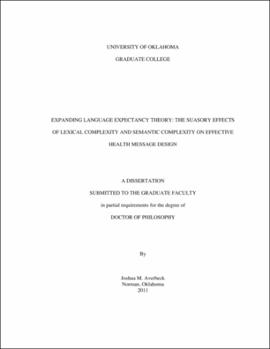| dc.contributor.advisor | Miller, Claude | |
| dc.creator | Averbeck, Josh | |
| dc.date.accessioned | 2019-04-27T21:34:17Z | |
| dc.date.available | 2019-04-27T21:34:17Z | |
| dc.date.issued | 2011 | |
| dc.identifier | 99307314602042 | |
| dc.identifier.uri | https://hdl.handle.net/11244/319050 | |
| dc.description.abstract | This research seeks to fill a gap concerning screening for sexually transmitted diseases (STDs) by using language expectancy theory (LET; Burgoon, Jones, & Stewart, 1975; Miller & Burgoon, 1979) and regulatory focus theory (RFT; Higgins, 1998; 2000; Higgins, Shah, & Friedman, 1997) to explore message design effectiveness as a function of semantic and lexical complexity, in a 2 (lexical: simple vs. complex) x 2 (semantic: | |
| dc.description.abstract | simple vs. complex) x 2 (source: doctor vs. peer) x 2 (appeal: prevention vs. promotion) design. Findings indicate the optimal message features resulted from the use of prevention focused, lexically simple, and semantically simple language given the receiver is less likely to think on an abstract level and is more likely to integrate new information. Future directions are discussed for health risk campaigns, and for advancement of the theoretical contributions offered by examining semantic complexity and lexical complexity within the explanatory frameworks of LET and RFT. | |
| dc.format.extent | 174 pages | |
| dc.format.medium | application.pdf | |
| dc.language | en_US | |
| dc.relation.requires | Adobe Acrobat Reader | |
| dc.subject | Sexually transmitted diseases--Prevention | |
| dc.subject | Communication in public health | |
| dc.subject | Health education | |
| dc.subject | Linguistics | |
| dc.title | EXPANDING LANGUAGE EXPECTANCY THEORY: THE SUASORY EFFECTS OF LEXICAL COMPLEXITY AND SEMANTIC COMPLEXITY ON EFFECTIVE HEALTH MESSAGE DESIGN | |
| dc.type | text | |
| dc.type | document | |
| dc.thesis.degree | Ph.D. | |
| ou.group | College of Arts and Sciences::Department of Communication | |
